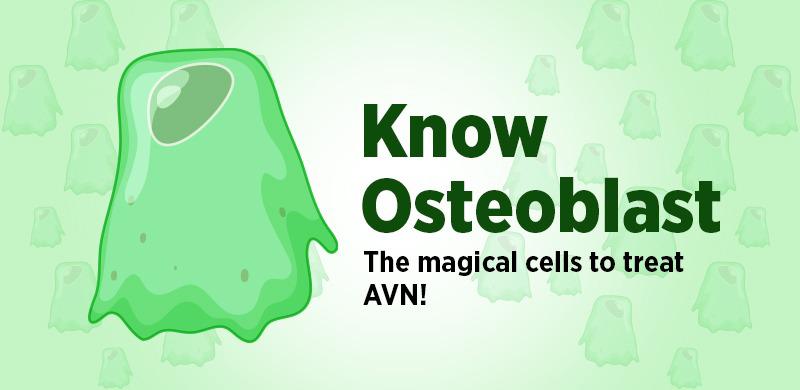© Copyright 2019. Regrow Biosciences Pvt Ltd. All Rights Reserved
Blog
© Copyright 2019. Regrow Biosciences Pvt Ltd. All Rights Reserved
Blog
Know Osteoblasts - the magical cells to treat AVN!
30th December 2022

Osteoblasts are the cells or building blocks of the bone. They lead to the ossification of the bones, also known as osteogenesis. These cells create and deposit organic bone matrix proteins that help in mineralization in growing skeletons and throughout a person's lifetime as their bones continue to remodel.
The process through which new bone is made is also known as ossification. In humans, ossification starts around the third month of pregnancy and is finished by late adolescence. The procedure has two general forms: one for cancellous bone, which includes portions of the skull, shoulder blades, and ends of long bones, and the other for compact bone, which comprises around 80% of the skeleton.
The two main methods of bone creation entail the conversion of mesenchymal tissue already present into bone tissue, namely: -
1.) Intramembranous ossification is the term for the process of mesenchymal tissue turning directly into the bone.
2.) Endochondral ossification refers to the formation and replacement of a cartilage intermediate by bone cells.
It is the distinctive process by which the flat bones of the skull and the turtle shell are created. Neural crest-derived mesenchymal cells proliferate and condense into compact nodules during intramembranous ossification in the skull.
In this process, mesenchymal cells aggregate to produce cartilage tissue, which is thereafter replaced by bone.
Avascular Necrosis is a degenerative bone disorder marked by the loss of bone cells because of the subchondral blood supply being cut off. The epiphyses of long bones at weight-bearing joints are typically affected. The femoral head, knee, talus, and humeral head are the locations where AVN occurs most frequently. Overall, the hip is the most frequently used region, often leading to hip pain and, in worst - case scenarios, being the cause of hip fractures.
These are the following regions commonly affected by this condition: -
1) Hip
2) Knee
3) Shoulder
4) Talus
1) Physical examination is futile in early diagnosis. Recent trauma, steroid usage, alcoholism, tobacco use, change in gait, poor posture, insidious onset pain, and reduced range of motion should be mentioned in a focused history.
2) X-ray is ineffective in the early stages
MRI is highly effective in the early detection
Avascular necrosis treatment is done through the region affected as follows: -
a) Non-operative treatments (Alendronate only therapy and bisphosphonates combination)
b) Total hip arthroplasty
c) Core decompression
a) Physiotherapy
b) A noncompartmental knee replacement
c) total knee replacement
a) Nonoperative treatment such as pain control, physiotherapy
total shoulder replacement for severe cases
a) operative anatomic reduction and stable fixation
Our healthcare professionals are continuously studying the different ways through which we can manage this condition effectively. One such recent advancement in the treatment of AVN is Ossgrow also known as Bone cell therapy. It is a method where healthy cells are utilized to treat a diseased organ or tissue.
Osteoblasts are responsible for the formation of new bones. Due to several factors, a condition such as avascular necrosis can occur, which leads to the degeneration of the bones. There are several treatment methods according to the region affected, such as physical therapy, anti-inflammatory drugs, and surgery, but there is an effective treatment where surgery can be avoided. As we know in AVN, due to the interruption of the blood supply to the bone, osteoblasts are also in short supply. This treatment focuses on the regeneration of bone cells and works by supplying cells from the patient’s healthy tissue to make bone-forming cells for each patient.